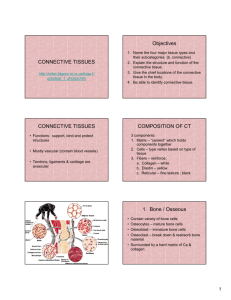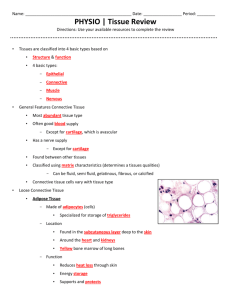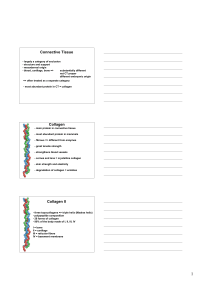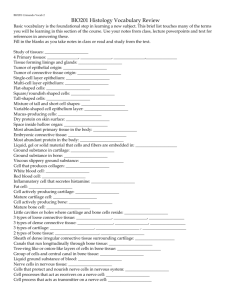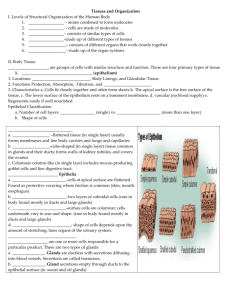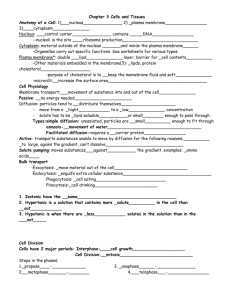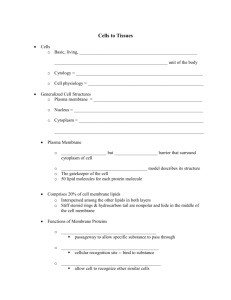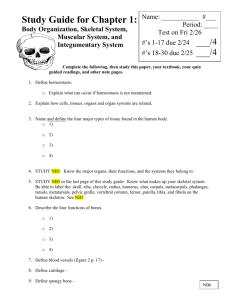2-Connective Tissue Lab
advertisement
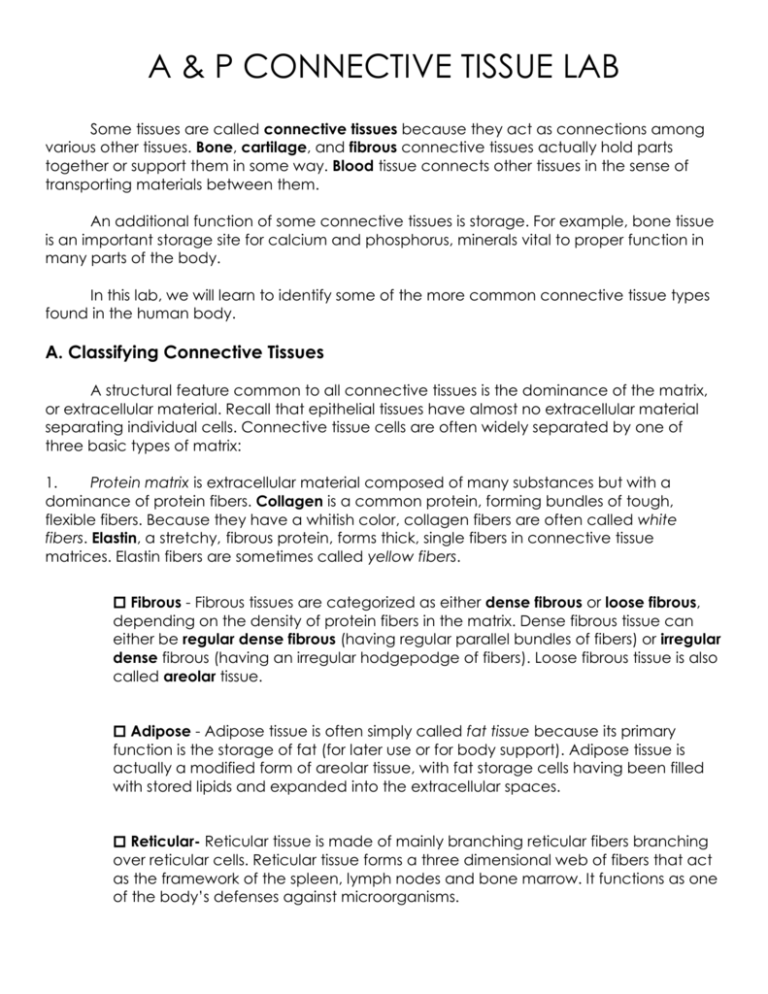
A & P CONNECTIVE TISSUE LAB Some tissues are called connective tissues because they act as connections among various other tissues. Bone, cartilage, and fibrous connective tissues actually hold parts together or support them in some way. Blood tissue connects other tissues in the sense of transporting materials between them. An additional function of some connective tissues is storage. For example, bone tissue is an important storage site for calcium and phosphorus, minerals vital to proper function in many parts of the body. In this lab, we will learn to identify some of the more common connective tissue types found in the human body. A. Classifying Connective Tissues A structural feature common to all connective tissues is the dominance of the matrix, or extracellular material. Recall that epithelial tissues have almost no extracellular material separating individual cells. Connective tissue cells are often widely separated by one of three basic types of matrix: 1. Protein matrix is extracellular material composed of many substances but with a dominance of protein fibers. Collagen is a common protein, forming bundles of tough, flexible fibers. Because they have a whitish color, collagen fibers are often called white fibers. Elastin, a stretchy, fibrous protein, forms thick, single fibers in connective tissue matrices. Elastin fibers are sometimes called yellow fibers. Fibrous - Fibrous tissues are categorized as either dense fibrous or loose fibrous, depending on the density of protein fibers in the matrix. Dense fibrous tissue can either be regular dense fibrous (having regular parallel bundles of fibers) or irregular dense fibrous (having an irregular hodgepodge of fibers). Loose fibrous tissue is also called areolar tissue. Adipose - Adipose tissue is often simply called fat tissue because its primary function is the storage of fat (for later use or for body support). Adipose tissue is actually a modified form of areolar tissue, with fat storage cells having been filled with stored lipids and expanded into the extracellular spaces. Reticular- Reticular tissue is made of mainly branching reticular fibers branching over reticular cells. Reticular tissue forms a three dimensional web of fibers that act as the framework of the spleen, lymph nodes and bone marrow. It functions as one of the body’s defenses against microorganisms. 2. Protein/ground substance matrix is extracellular material that has some protein fibers in it but also a great deal of nonfibrous protein and other substances. Cartilage - The matrix of cartilage is a combination of fibers and ground substance that gives it a rubbery quality. Hyaline cartilage - has a moderate amount of collagen fiber in its matrix. Fibrocartilage - as its name implies, has a large amount of collagen in its matrix. Elastic cartilage - is distinguished by the presence of elastin fibers, giving it a stretchy quality. Bone - There are two broad categories of bone: compact bone and cancellous (spongy) bone. Both have a matrix of collagen fibers encrusted with mineral crystals that give it a solid consistency. Compact bone forms rather large, dense pieces of bone matrix. Cancellous bone forms thin, narrow beams of hard bone matrix in which red bone marrow can be supported. 3. Fluid matrix is composed of a water-based solution with a fluid consistency. Blood is the major type of fluid matrix connective tissue. Another type of fluid- matrix tissue is hematopoietic tissue, which produces blood cells. Hematopoietic tissue is also called myeloid tissue, or simply red bone marrow. HINT Many cells found in connective tissues are named according to their action. Cells that produce matrix often have the suffix -blast ("make"). Cells that destroy matrix during remodeling have the suffix -clast ("break"). Cells that are in a relatively inactive mode have a -cyte ("cell") suffix. The first part of the name tells the specific kind of matrix involved: fibro("fiber"), chondro-("cartilage"), or osteo-("bone"). Thus fibroblasts make fibers chondroblasts manufacture cartilage matrix, and osteoblasts lay down bone matrix. Histologists often classify tissues for convenience in naming them, and for better identification of their nature. However, different histologists use slightly different schemes, depending on the context in which they are working. The histology schemes used in this lab are fairly universal. Table 1 summarizes the locations and functions of some of the major types of connective tissue. Table 1. Examples of Major Connective Tissues TISSUE Fibrous LOCATION FUNCTION Between other tissues and organs, superficial fascia Connection Under skin, Padding at various points Protection, Insulation, Support, Reserve Food Inner framework of spleen, lymph nodes, bone marrow Support, Filtration Regular Tendons, Ligaments, Aponeurosis Flexible but strong connection Irregular Deep fascia, Dermis, Scars, Capsule of Kidney Connection, Support Compact Skeleton Support, Protection, Calcium reservoir Cancellous Skeleton Supports bone marrow Part of nasal septum, Covering articular surfaces of bones, Larynx, Rings in trachea and bronchi Firm but flexible support Disks between vertebrae, Symphysis pubis Firm but flexible support Elastic External ear, Auditory (Eustachian) tube Firm but flexible support Blood In blood vessels Transportation, Protection Skeleton (in cavities of cancellous bone Blood tissue production Loose, ordinary (areolar) Adipose (fat) Reticular Dense Fibrous Bone Cartilage Hyaline Fibrocartilage Fluid Hematopoietic DIRECTIONS: Using the following diagrams, determine which type of connective tissue is described and record the answers on your Lab Report section A. Figure 1. Figure 2. B. MICROSCOPE SPECIMENS CAUTION Avoid electrical hazards while using the microscope. Be sure to exercise care in dealing with broken glass slides. Don't reach for slides or other objects while you are looking into the ocular. You may knock over something or bump into someone. This activity asks you to observe representative connective tissue types in prepared specimens. For each type listed in the following steps, locate an example in a slide and sketch it in the Lab Report. 1. Loose, ordinary fibrous (areolar) connective tissue- Areolar (meaning "spacious") forms loose bonds between other tissues. For example, under the skin, it allows the skin to be slid around over, or pulled from, the underlying muscle to some degree. Both collagen and elastin fibers are found in this tissue but are widely spaced. Blood vessels, as well as nerves, course through it. A variety of cell types may be found here: fibrocytes, adipose cells, and white blood cells. LANDMARK CHARACTERISTICS Areolar tissue's widely spaced fibers and variety of cell types make it easy tissue to identify. The elastin fibers appear as dark, thick, jagged strands. Collagen fibers form bundles that often appear as hazy pink or light purple crisscrossing lines. 2. Adipose tissue - Adipose cells are specialized to store lipids in large vesicles. The vesicle can be so large that it pushes the nucleus and other organelles up to the cell membrane, which enlarges to accommodate the large cell volume. If the adipose cells in areolar tissue enlarge (because of increased storage of fat), they crowd the fibers and other cells, eventually forming adipose tissue. Thus, adipose tissue has very little matrix compared to other connective tissue types. Adipose tissue is found wherever areolar tissue is found but is most often seen around the heart and under the skin. It not only stores lipids for later use; it also serves as a support (as in the breasts), as insulation (under the skin), and as a cushion (you're sitting on it). LANDMARK CHARACTERISTICS Unlike other connective tissue cells, adipose cells are very close to one another. The large fat globule inside each cell pushes the cytoplasm and organelles into a thin, dark ring around the inside of the cell membrane. The nucleus often appears as a bulge in the ring. The most obvious characteristic of this tissue is the presence of large fat vesicles, which generally look clear, yellowish, or light pink. The overall appearance is that of a host of large bubbles. 3. Reticular tissue - Reticular tissue is named for a word that means "network"-referring to this tissue's characteristic three-dimensional web of fine reticular fibers. The fine fibers that characterize this tissue are made of a special type of collagen. Reticular cells are found overlaying the fine fibers that form the reticular meshwork. Branches of the cytoplasm of reticular cells follow the branching reticular fibers. Reticular fiber tissue forms the network of the spleen, lymph nodes, and bone marrow cavities. It functions as part of the body's defensive system. LANDMARK CHARACTERISTICS Reticular tissue is characterized by a network of extremely thin reticular fibers that are either stained darkly so that they can be seen easily or not stained at all- making them practically invisible under ordinary magnification. Reticular cells can be seen up against the fibers, with cell shapes that seem to conform to the branches of the reticular meshwork. 4. Dense fibrous connective tissue - As its name implies, this tissue is a dense arrangement of fibers. They may be collagen fibers or elastic fibers. Their arrangement may be regular (roughly parallel) or irregular (swirling or random). Interspersed among the fibers of a mature tissue are fibrocytes. Irregular dense fibrous tissue forms the lower layer of the skin (dermis), much of the body's fascia, and the capsules of many organs. Regular dense fibrous tissue is used for structures that require a better-engineered connection between parts that are pulled with great force. For example, this tissue forms tendons (connecting muscle to bone) and ligaments (connecting bone to bone). LANDMARK CHARACTERISTICS -----Regular dense fibrous tissue usually has a roughly parallel arrangement of either collagen or elastic fibers. Collagen appears as thick fibers stained dark violet or blue. Darkly stained fibrocytes are scattered between fibers or fiber bundles, often in groups. -----Irregular dense fibrous tissue is virtually the same as regular tissue in composition. Irregular tissue is different because the fibers appear as chaotic swirls rather than parallel lines. 5. Hyaline cartilage - All cartilage is distinctive in the consistency of its semisolid rubbery matrix of protein fibers mixed with other substances. Chondrocytes are scattered throughout the matrix in little pockets called lacunae (meaning "lakes"). Hyaline cartilage has a moderate amount of collagen, giving it a great deal of toughness along with its cushiony quality. This cartilage type forms the bulk of the fetal skeleton (before it is replaced by bone) and continues to be the most abundant type of cartilage throughout life. It forms the thin, rubbery layer over the ends of long bones and is found in parts of the trachea, larynx, and nose. LANDMARK CHARACTERISTICS The collagen fibers of hyaline cartilage are not distinct in the matrix, which has a smooth, pinkish, or lavender appearance in many preparations. The chondrocytes are usually pink to violet and appear to have shriveled within their respective lacunas. Because of chondrocyte shrinkage, a clear ring appears around the inside of many lacunae. 6. Fibrocartilage - The name of this tissue indicates its high concentration of collagen fibers. These fibers give the tissue a distinctive fibrous appearance. Fibrocartilage has a more rigid, less rubbery consistency than other cartilage types. Fibrocartilage forms the disks between vertebrae and may be found at other semimoveable joints. LANDMARK CHARACTERISTICS Fibrocartilage may appear alongside hyaline cartilage and sometimes looks very similar. However, the distinct fibrous appearance of fibrocartilage’s matrix is it’s determining factor. 7. Elastic cartilage - As its name implies, elastic cartilage has a large proportion of elastin fibers in its matrix. Elastic cartilage is found in structures where springiness is desirable in the support material. For example, the elasticity of the pinna (ear flap) is provided by elastic cartilage LANDMARK CHARACTERISTICS In many preparations, elastin fibers stain very darkly. This makes their presence easy to detect and allows one to distinguish elastic cartilage without any problem. 8. Compact bone - Compact bone is formed by solid, cylindrical units called osteons packed tightly together. The osteon, or Haversian system, consists of multiple concentric layers of hard bone matrix, with cells sandwiched between each layer. Each layer is a lamella (plural lamellae). Osteocytes are literally trapped within lacunae between the lamellae. The osteocytes were once active osteoblasts but have trapped themselves in the solid matrix they formed. The lamellae are centered around the haversian canal's blood vessels. The cells transport materials to and from the canal by way of tiny canaliculi ("small canals") that connect the osteocytes to each other and to the canal. LANDMARK CHARACTERISTICS A cross section of compact bone has rings of lamellae surrounding several adjacent haversian, or central, canals. The lamellae resemble rings in an onion slice. The central canals are either clear or nearly black, the lamellae buff to orange, and the osteocytes brown or black. The canaliculi often appear as wavy hairlines radiating from the lacunae. 9. Cancellous bone and hematopoietic tissue - Cancellous bone is easily identified by its open, lattice-like structure. Thin plates of bone matrix, with a scattering of osteocytes trapped within lacunae, form structural beams that have great strength despite the open spaces. These beams of hard bone are called trabeculae. Because cancellous bone has open spaces, it is sometimes called spongy bone. This name can be misleading because one might think spongy bone is as soft as a bath sponge. It isn't soft at all because it has hard trabeculae. The spaces are filled with hematopoietic or myeloid tissue, a special type of blood tissue that produces new blood cells. Hematopoietic tissue is also called red bone marrow. LANDMARK CHARACTERISTICS Cancellous bone is distinguished by its rather disorganized array of trabecular beams of bone surrounded by myeloid tissue. The bone pieces may look like slivers of compact bone, with lamellae that often don't form complete circles. The myeloid tissue is a scattering of blood cells, which appear as tiny, dark circles. Myeloid (hematopoietic) tissue may also have a network formation of very thin collagen fibers called reticular fibers. In some preparations, the bone tissue is pink, and the myeloid cells are dark red. 10. Blood - Blood tissue is a fluid matrix connective tissue characterized by a variety of cell types. Tiny red blood cells (RBCs), tinier fragments called platelets, and larger white blood cells (WBCs) may all be seen in a blood-smear preparation. Of course, blood is found within the circulation vessels and has many functions. Blood transports and exchanges materials, serves in immune protection of the body, and helps regulate body temperature, among other functions. LANDMARK CHARACTERISTICS A prepared blood smear is a drop of blood smeared on a slide and stained. The red blood cells are the more numerous, smaller cells stained pink to orange-red. RBCs have no nuclei. The white blood cells are much larger, with distinct, often distorted nuclei. CONNECTIVE TISSUE LAB REPORT NAME ________________________________________________________________ PERIOD ________ A. Identifying: Using your lab handout, identify and list key characteristics (notes) of connective tissues. Figure 1 1 2 3 4 5 Figure 2 1 2 3 4 5 6 Tissue type Notes B. Microscopy: (using proper microscope technique, pull up the slides at your lab table and make drawings of them in the respective places). If no slides are available, use drawings from your textbook or overhead transparencies. Specimen: dense fibrous( irregular) connective tissue Total magnification: __________ Specimen: reticular tissue Total magnification: __________ Specimen: loose fibrous (areolar) tissue Total magnification: __________ Specimen: elastic cartilage Total magnification: __________ Specimen: hyaline cartilage Total magnification: __________ Specimen: fibrocartilage Total magnification: __________ Specimen: ground bone Total magnification: __________ Specimen: blood smear Total magnification: __________ Specimen: cancellous bone Total magnification: __________ Specimen: adipose tissue Total magnification: __________ C. Matching (may be used more than once or not at all) a. b. c. d. dense fibrous connective tissue adipose tissue hyaline cartilage fibrocartilage _____ _____ _____ _____ _____ _____ _____ _____ 1. 2. 3. 4. 5. 6. 7. 8. e. f. g. elastic cartilage compact bone cancellous bone Cartilage type with a great deal of collagen in the matrix Tissue type that stores lipid molecules Tissue type composed of haversian systems The most common type of cartilage Strong tissue that forms tendons and ligaments Tissue type associated with red bone marrow Connective tissue that forms the disks between vertebrae Tissue type that contains hard mineral trabeculae D. Concept Mapping DIRECTIONS:Using the following terms, construct a concept map below. Hematopoietic, Adipose, Dense, Connective tissues, Fluid, Fibrocartilage, Blood, Fibrous, Irregular, Compact, Hyaline, Reticular, Areolar, Cartilage, Cancellous, Elastic, Bone, Regular
